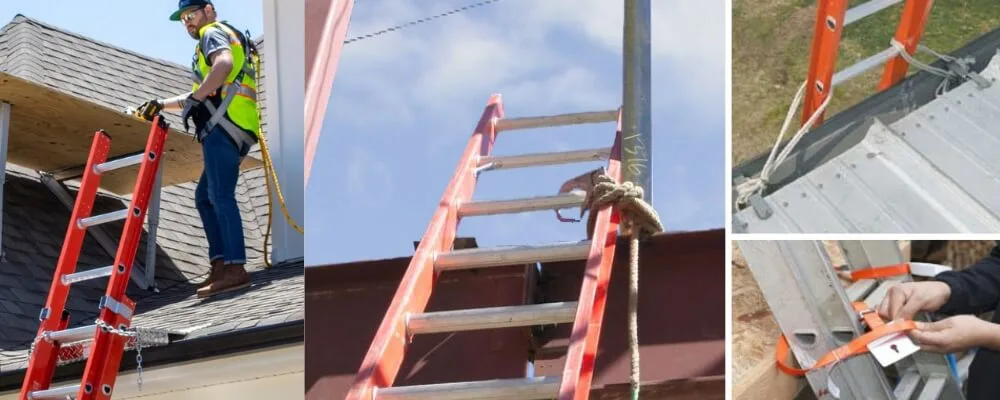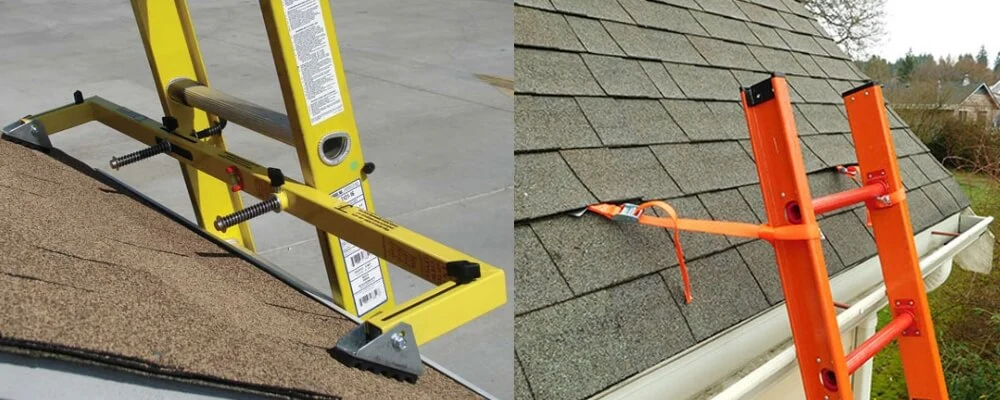In various professional and domestic scenarios, ladders serve as indispensable tools, enabling individuals to reach elevated heights and perform tasks efficiently. However, the utility of a ladder is closely intertwined with the paramount importance of safety.
A ladder, if not secured properly, can become a precarious apparatus, leading to severe accidents and injuries. Recognizing the criticality of ladder safety, this blog elucidates 12 effective tips on how to tie off a ladder securely, aiming to foster a safer working environment and mitigate the risks associated with ladder use.
These tips are meticulously designed to guide users through the process of choosing suitable anchor points, positioning the ladder correctly, and securing it firmly, ensuring stability and safety. Whether you are a seasoned professional accustomed to working at heights or a homeowner undertaking a DIY project, adhering to these guidelines can significantly enhance your safety and confidence while using a ladder.
Reasons For Tie Off a Ladder
Tying off a ladder is a critical safety measure, and there are several reasons for doing so:
- Prevent Slipping or Shifting: Tying off a ladder helps prevent it from slipping or shifting while someone is on it. This is crucial, especially when the ladder is placed on a smooth or uneven surface, as it provides additional stability and reduces the risk of accidents.
- Enhance Stability: Even on a level and rough surface, external factors like wind can cause the ladder to become unstable. Tying off the ladder to a solid anchor point ensures that it remains stable in various conditions, providing a secure platform for individuals to work on.
- Compliance with Safety Regulations: Occupational safety regulations, such as those outlined by OSHA, often require ladders to be secured to prevent accidents in the workplace. Tying off a ladder is a fundamental practice to comply with these regulations and maintain a safe working environment.
- Prevent Toppling: When working at significant heights, there is a risk of the ladder toppling due to overreaching or shifting weight. Securing the ladder helps in mitigating this risk by providing a fixed point, preventing the ladder from falling over.
- Increase Confidence: Knowing that the ladder is securely tied off can increase the confidence of the person using it. This can lead to better focus and efficiency as the individual can work without the constant fear of the ladder moving or falling.
- Protect Bystanders: A secured ladder is less likely to fall or shift, reducing the risk to people passing by or working near the ladder. This is especially important in busy work environments where multiple activities are happening simultaneously.
- Prevent Property Damage: A falling ladder can cause significant damage to property, including vehicles, windows, and other structures. Tying off the ladder helps in preventing such incidents, protecting the surroundings from potential damage.
- Enhance Productivity: With the ladder securely tied off, workers can perform tasks more efficiently without having to reposition the ladder frequently. This can lead to improved productivity as work can be completed faster and with less interruption.
- Extend Ladder Life: Regularly securing the ladder can also contribute to extending its life. When a ladder is tied off properly, it is less likely to experience stress and strain that can lead to wear and tear, thus prolonging its usability.
- Risk Mitigation: Ultimately, tying off a ladder is a proactive measure to mitigate the risks associated with ladder use. It is a simple yet effective way to ensure the safety of individuals and the environment they are working in.
By understanding and implementing ladder tie-off practices, individuals and organizations can significantly reduce the likelihood of accidents and injuries related to ladder use.

How to Tie Off a Ladder for Safety
Tying off a ladder for safety is crucial to prevent accidents and ensure stability while working at heights. Here’s a general guide on how to tie off a ladder securely:
1. Choosing a Suitable Anchor Point
When selecting an anchor point, it is crucial to choose a solid, immovable object, such as a sturdy post or a structural member of a building, to ensure the ladder remains stable. The anchor point is the foundation of ladder safety as it holds the ladder in place, preventing it from slipping or falling.
It is essential to avoid tying the ladder to unstable or fragile objects like vents or plastic pipes, as these can easily break or shift, leading to accidents.
2. Positioning the Ladder Properly
Proper ladder placement is vital for maintaining balance and preventing tipping. The ladder should be placed on a firm, level surface to avoid any wobbling or instability. The correct angle is also crucial; a good rule of thumb is the 4-to-1 rule, meaning for every four feet of height, the base of the ladder should be one foot away from the wall. This angle provides optimal stability and reduces the risk of the ladder falling backward.
3. Securing the Base
The base of the ladder needs to be secure to prevent any movement while climbing. Using ladder stabilizers or levelers can help if the ground is uneven, providing additional support. If possible, having someone hold the base of the ladder while climbing can offer extra security. This person can also alert the climber to any potential issues and assist in emergencies, making this a valuable safety measure.
4. Using the Right Rope
Selecting a strong, durable rope is essential when tying off a ladder. A braided nylon rope or another suitable material is recommended due to its strength and durability. The rope is a critical component in securing the ladder, and using damaged or frayed ropes can compromise safety, as they can snap under tension, causing the ladder to become unstable or fall.
5. Tying the Top of the Ladder
The ladder should extend at least 3 feet above the landing point to provide a handhold when stepping off. The rope should be tied securely around the top rung of the ladder to ensure it doesn’t slip. Wrapping the other end of the rope around the anchor point and securing it with a suitable knot, such as a bowline or a clove hitch, is crucial. These knots are known for their strength and reliability, ensuring the ladder remains firmly in place.

6. Securing the Bottom
If possible, the bottom of the ladder should also be tied to another solid anchor point to prevent the ladder from kicking out. This double anchoring provides additional stability, especially when working at significant heights.
If no suitable anchor points are available, using stakes driven into the ground or sandbags can also secure the base effectively. These measures prevent the ladder from shifting, providing a safer climbing experience.
7. Checking Stability
Before ascending the ladder, it is imperative to check its stability by giving it a gentle shake. This action will help in identifying any movement or instability in the ladder, ensuring that it is securely tied off and safe to climb.
If any instability is detected, adjustments should be made immediately to secure the ladder properly. This step is crucial as it verifies that all the previous safety measures have been correctly implemented, providing confidence to the climber that the ladder is stable and secure.
8. Using Personal Protective Equipment
When working at heights, wearing a safety harness connected to a suitable anchor point is essential. This equipment acts as a fail-safe, protecting the individual from falls. Additionally, using a ladder with the appropriate weight capacity is crucial to accommodate both the individual and their tools safely.
Overloading the ladder can lead to breakage or tipping, so adhering to weight limits is a fundamental aspect of ladder safety. PPE acts as the last line of defense against accidents, making it a critical component of safe ladder use.
9. Inspecting the Ladder
Before utilizing the ladder, a thorough inspection is necessary to identify any defects or damage such as cracks, corrosion, or missing parts. Using a damaged or defective ladder can lead to catastrophic failures, so any ladder found to be in unsatisfactory condition should not be used under any circumstances.
Regular inspections help in early detection of potential issues, allowing for timely repairs or replacements, thus maintaining a high level of safety during ladder use.
10. Climbing Safely
Maintaining three points of contact while climbing, either two hands and one foot or two feet and one hand, is essential for balance and stability. This technique reduces the risk of falls by providing constant support and grip during ascent and descent.
Carrying heavy or bulky items while climbing is not recommended as it can lead to loss of balance; instead, using a tool belt or a hoist to transport tools and materials is advised. Climbing safely is about minimizing risks and ensuring that the climber has maximum control and support at all times.

11. Following Regulations
Adherence to OSHA standards and any other local regulations regarding ladder safety is mandatory. These regulations are designed to protect individuals from accidents and ensure a safe working environment.
Additionally, following the manufacturer’s instructions and guidelines for ladder use is crucial as it provides specific information on the proper use and limitations of the ladder. Compliance with regulations and guidelines ensures that all safety protocols are observed, creating a structured and secure working scenario.
12. Untying Safely
After completing the work, it is important to untie the ladder carefully. Before descending, the climber should ensure that the ladder is stable. This step is crucial as it ensures that the ladder does not move unexpectedly during descent, which could lead to falls.
Untying safely is the final step in the ladder safety process, and it requires attention and care to avoid any last-minute accidents. It concludes the safe ladder use cycle, allowing the ladder to be removed and stored securely until next use.
Conclusion
In conclusion, the importance of tying off a ladder cannot be overstated as it stands as a pivotal practice in ensuring safety and preventing accidents. The 12 effective tips outlined in this blog serve as a comprehensive guide, providing insights into the meticulous process of securing a ladder properly. From selecting robust anchor points to maintaining the correct ladder angle and using durable ropes, each step is crucial in building a secure and stable setup, allowing individuals to work at heights with confidence and peace of mind.
Adherence to these safety measures not only aligns with occupational safety regulations but also contributes to creating a safer and more productive working environment, whether in professional settings or during home projects. By implementing these practices, we can mitigate the risks associated with ladder use, protect those around us, and prevent potential property damage, fostering a culture of safety and responsibility.
Remember, the effectiveness of these tips lies in their consistent application. Regular inspections, proper positioning, and secure tie-offs should become second nature to every ladder user. Let’s embrace these safety tips and make every climb a secure one, ensuring that the convenience provided by ladders is complemented by unwavering safety and reliability.

